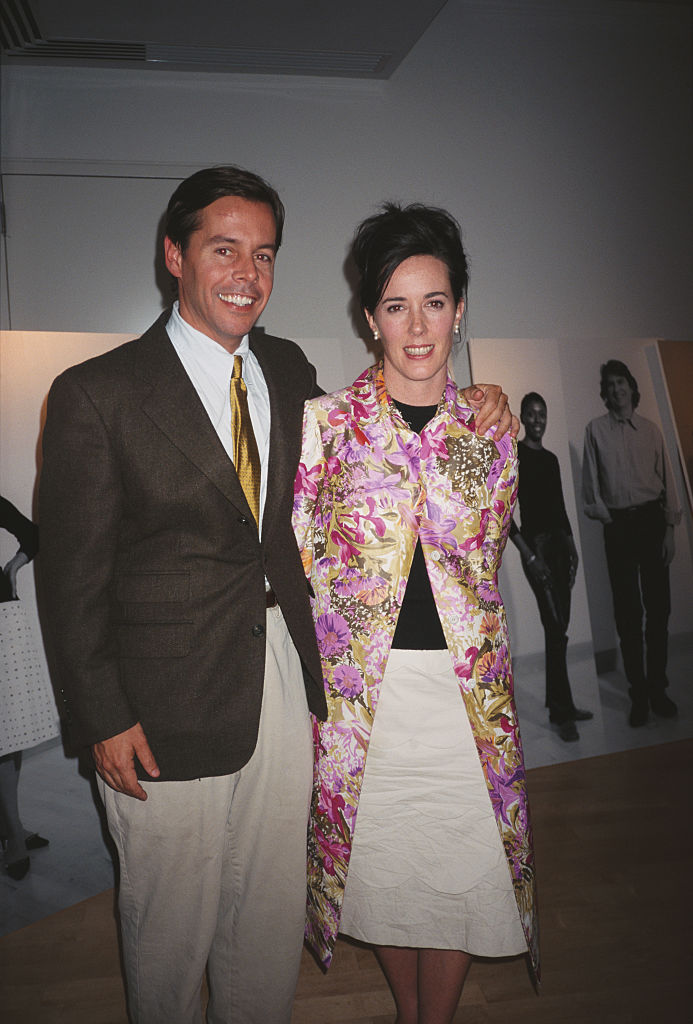While there were many stand-out brands of the 1990s, there’s one that particularly comes to mind as the “it” handbag brand of the decade: Kate Spade New York. Everywhere you looked, you could find a woman carrying the “Sam” tote, the boxy, square, catch-all. If you were a teenager or in your 20s or 30s in the ‘90s, you likely owned a Kate Spade bag at some point, or had it high up on your gift wish list. In short, Kate Spade New York was nothing short of iconic—and still continues to be a beloved, thriving brand today. Below, we take you through the evolution of Kate Spade New York from the 1990s to present day, and explain why it’s still such a successful brand decades later.
History of Kate Spade New York
Kate Spade New York was founded in January 1993 by editor-turned-designer Katherine Noel Brosnahan—also known as Kate Spade—and her husband, Andy Spade. Previous to starting the fashion empire brand, Kate worked as a style/accessories editor at Mademoiselle Magazine. She was at Mademoiselle for around six years, and then decided to take a leap of faith to design her own handbag line, a suggestion that originally came from Andy.

Before she left Mademoiselle, Kate was the senior style editor. She wasn’t sure if she wanted to take the next steps down that path, which is when Andy pitched the idea of starting a handbag business, as Kate loved finding unique bags. She made a model out of construction paper and tape, and the next thing you know, she was making real handbags to sell to the masses.
Kate Spade bags gained lots of attention the first few years, and was eventually bought by Neiman Marcus in 1999. Later, Liz Claiborne bought the company from Neiman Marcus, and after that (and still today), the company was owned by Tapestry, Inc.
What handbag brand would you like to learn about next?
History of Kate Spade New York’s square bag
Kate Spade’s first bag they designed was the “Sam,” a sleek, sophisticated, square handbag. If you know anything about Kate Spade New York, you probably know they are known for their square shapes. The bag was a major hit, and widely sought-after by hundreds of thousands of people in the ‘90s and 2000s. It was their signature, if you will, and was released in dozens of colors and patterns.
In fact, the Sam was so beloved and popular that the brand brought it back in 2018 as one of their “icons.” Kate Spade New York Sam bag is still available to purchase today, currently available in black, off-white and blue.
Evolution of Kate Spade New York
Kate Spade New York in the 1990s
As mentioned above, Kate Spade New York was a major moment in the ‘90s. Everyone wanted to own a Sam bag, and the brand was known for their bold approach to color and patterns. They weren’t afraid of color; rather, they leaned into it.
Once they established their handbag line, Kate Spade New York decided to tap into the shoe business. Kate Spade shoes are also still very iconic, aside from their handbags, and are still sold today.
Kate Spade New York was sold online and in various department stores across the country. They had several Kate Spade New York stores around the U.S., but not nearly as many as they do today—only about 13 locations at the time.
Kate Spade New York today

Kate Spade New York continues to be an iconic fashion brand today, with hundreds of store locations and sold in hundreds of retail department stores.
And they didn’t stop at handbags and shoes. While Kate Spade bags and shoes are still a major part of the business, they now have a full women’s clothing line, as well as jewelry, perfume, sunglasses and even home goods such as paper products like stationery and calendars. They continue to experiment with color and patterns, and have come out with dozens of fun, unexpected collabs. In fact, they just announced a Kate Spade New York x M&M’s collaboration that will be released on November 1.
As far as their handbag designs, they now have a variety of shapes and sizes aside from the classic square bag. There truly is a shape and style for everyone, from small shoulder bags to large catch-all totes.
Unfortunately, Kate tragically passed away by suicide in 2018. In response, Tapestry, Inc. (the owner of Kate Spade New York) announced they would donate $1 million toward mental health support. This past September, Kate Spade New York launched the Global Fund for Women’s Mental Health, which “focuses on bringing needed investment and increased access to community-led mental health interventions for women and girls,” the brand’s website states.




